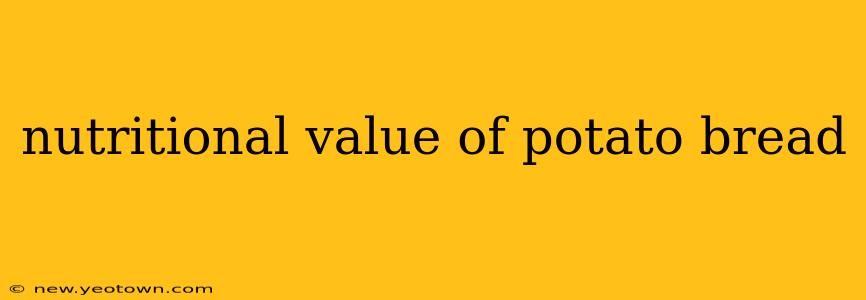Ah, the humble potato. A culinary chameleon, transforming from simple spud to creamy mash, crispy fries, and even the comforting texture of potato bread. But beyond its delightful taste, what's the nutritional story behind this popular loaf? Let's peel back the layers and explore the nutritional value of potato bread, addressing some common questions along the way.
What are the nutritional benefits of potato bread?
Potato bread, unlike its wheat-based counterpart, often boasts a slightly different nutritional profile. While the exact values vary depending on the specific recipe and ingredients used (think added sugars, oils, and types of flour), generally, potato bread can offer some unique advantages. The addition of potatoes can contribute to a softer texture and a slightly sweeter taste, and can potentially increase the bread's fiber content, depending on the type of potato and the recipe. Potatoes are also a source of potassium, a crucial mineral for maintaining healthy blood pressure.
Is potato bread healthier than white bread?
This is a question with no simple yes or no answer. It depends! While potato bread might offer a slight edge in terms of potassium and potentially fiber, the overall healthfulness depends on the entire ingredient list. Some potato breads are made with refined white flour, negating many of the potential health benefits. Others incorporate whole wheat flour or other whole grains, significantly boosting their nutritional profile. Always check the nutrition label to compare the total carbohydrate, sugar, fiber, and fat content to similar white bread options. Look for lower sugar content and higher fiber—these are usually good indicators of a healthier choice.
How many calories are in a slice of potato bread?
The calorie count in a single slice of potato bread can vary greatly, ranging from around 70 to 100 calories or more. This depends on the size of the slice, the recipe, and the type of flour used. For a precise calorie count, always refer to the nutritional information on the specific bread packaging. Remember that calorie intake is a part of a larger picture—consider your overall daily caloric needs and dietary choices.
Does potato bread contain gluten?
Most potato breads do contain gluten, unless specifically labeled as gluten-free. This is because many recipes use wheat flour, which contains gluten, as a primary ingredient. Individuals with celiac disease or gluten intolerance must exercise caution and carefully check labels to ensure the bread is certified gluten-free. Gluten-free versions often utilize alternative flours such as rice flour or potato starch.
Is potato bread good for weight loss?
Like any bread, potato bread should be consumed in moderation as part of a balanced diet. It’s not inherently a "weight-loss food," but its calorie count can be similar to or slightly higher than white bread, depending on the recipe. Focusing on a whole-food-based diet, regular exercise, and mindful eating habits are key to achieving sustainable weight loss. A slice of potato bread can be part of a healthy diet, but it shouldn't be the cornerstone of a weight-loss plan.
The Bottom Line: Making Informed Choices
The nutritional value of potato bread varies widely depending on the ingredients. While it might offer some nutritional advantages over some white breads, particularly in potassium content, it's crucial to compare nutritional labels and make informed choices. Prioritize bread made with whole grains, less added sugar, and a higher fiber content for maximum nutritional benefits. Ultimately, the best bread for you is the one that fits into your overall healthy eating pattern.

